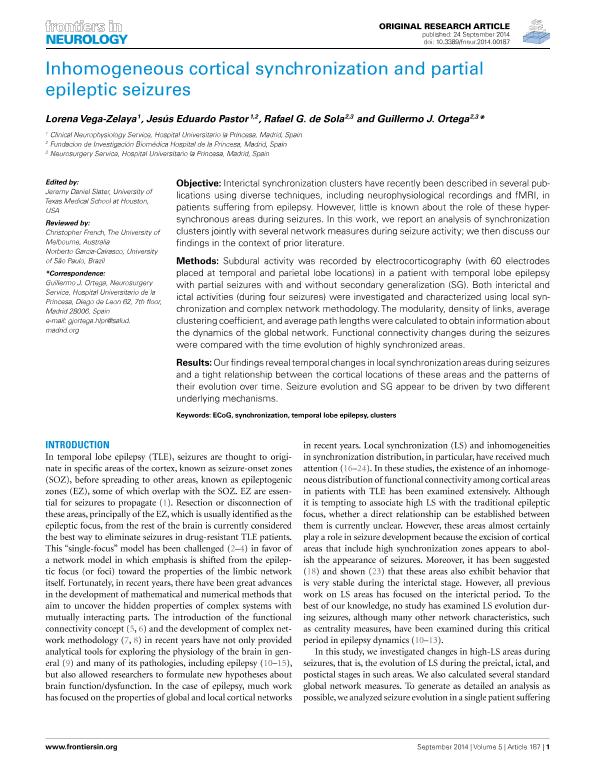Mostrar el registro sencillo del ítem
dc.contributor.author
Vega Zelaya, Lorena
dc.contributor.author
Pastor, Jesús Eduardo
dc.contributor.author
García de Sola, Rafael
dc.contributor.author
Ortega, Guillermo José

dc.date.available
2020-05-14T13:47:11Z
dc.date.issued
2014-09
dc.identifier.citation
Vega Zelaya, Lorena; Pastor, Jesús Eduardo ; García de Sola, Rafael; Ortega, Guillermo José; Inhomogeneous cortical synchronization and partial epileptic seizures; Frontiers Media S.A.; Frontiers in Neurology; 5; 187; 9-2014; 1-11
dc.identifier.issn
1664-2295
dc.identifier.uri
http://hdl.handle.net/11336/105095
dc.description.abstract
Objective: Interictal synchronization clusters have recently been described in several publications using diverse techniques, including neurophysiological recordings and fMRI, in patients suffering from epilepsy. However, little is known about the role of these hypersynchronous areas during seizures. In this work, we report an analysis of synchronization clusters jointly with several network measures during seizure activity; we then discuss our findings in the context of prior literature.Methods: Subdural activity was recorded by electrocorticography (with 60 electrodesplaced at temporal and parietal lobe locations) in a patient with temporal lobe epilepsywith partial seizures with and without secondary generalization (SG). Both interictal andictal activities (during four seizures) were investigated and characterized using local synchronization and complex network methodology. The modularity, density of links, average clustering coefficient, and average path lengthswere calculated to obtain information about the dynamics of the global network. Functional connectivity changes during the seizures were compared with the time evolution of highly synchronized areas.Results: Our findings reveal temporal changes in local synchronization areas during seizuresand a tight relationship between the cortical locations of these areas and the patterns oftheir evolution over time. Seizure evolution and SG appear to be driven by two differentunderlying mechanisms.
dc.format
application/pdf
dc.language.iso
eng
dc.publisher
Frontiers Media S.A.

dc.rights
info:eu-repo/semantics/openAccess
dc.rights.uri
https://creativecommons.org/licenses/by/2.5/ar/
dc.subject
EEG
dc.subject
CLUSTERS
dc.subject
TEMPORAL LOBE EPILEPSY
dc.subject
COMPLEX NETWORKS
dc.subject.classification
Neurología Clínica

dc.subject.classification
Medicina Clínica

dc.subject.classification
CIENCIAS MÉDICAS Y DE LA SALUD

dc.title
Inhomogeneous cortical synchronization and partial epileptic seizures
dc.type
info:eu-repo/semantics/article
dc.type
info:ar-repo/semantics/artículo
dc.type
info:eu-repo/semantics/publishedVersion
dc.date.updated
2020-05-11T15:12:31Z
dc.journal.volume
5
dc.journal.number
187
dc.journal.pagination
1-11
dc.journal.pais
Suiza

dc.journal.ciudad
Lausanne
dc.description.fil
Fil: Vega Zelaya, Lorena. Hospital Universitario la Princesa; España
dc.description.fil
Fil: Pastor, Jesús Eduardo. Hospital Universitario la Princesa; España
dc.description.fil
Fil: García de Sola, Rafael. Hospital Universitario la Princesa; España
dc.description.fil
Fil: Ortega, Guillermo José. Consejo Nacional de Investigaciones Científicas y Técnicas; Argentina. Universidad Nacional de Quilmes; Argentina
dc.journal.title
Frontiers in Neurology
dc.relation.alternativeid
info:eu-repo/semantics/altIdentifier/doi/http://dx.doi.org/10.3389/fneur.2014.00187
dc.relation.alternativeid
info:eu-repo/semantics/altIdentifier/url/https://www.frontiersin.org/articles/10.3389/fneur.2014.00187/full
Archivos asociados
